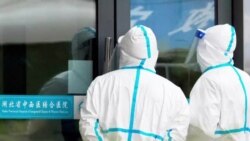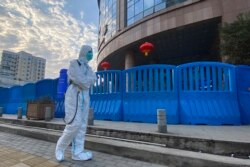On May 26, U.S. President Joe Biden released a statement calling on the intelligence community “to redouble their efforts to collect and analyze information” that could allow a “definitive conclusion” on the origins of SARS-CoV-2, the virus behind the deadly COVID-19 pandemic.
That statement said U.S. intelligence “has ‘coalesced around two likely scenarios’” — that SARS-CoV-2 either “emerged from human contact with an infected animal or from a laboratory accident.”
The Wall Street Journal also reported on May 23 that three researchers at the Wuhan Institute of Virology (WIV) had been hospitalized in November 2019 “with symptoms consistent with both COVID-19 and common seasonal illness.” The story cited a U.S. intelligence report as the source.
Research at the institute included the study of coronaviruses collected from bats. Wuhan, of course, is where COVID-19 was first detected in December of 2019.
Chinese state media have gone on the offensive, repeatedly dismissing the lab-leak theory with misleading claims.
They include a report posted June 4 by the China Global Television Network (CGTN), headlined, “Expert: Zero evidence that virus came out of a lab in China.” The report relies on quotes from Peter Daszak, an expert on disease ecology, who was a member of the World Health Organization (WHO) fact-finding mission that went to Wuhan earlier this year to investigate the pandemic origins.
The CGTN report included a clip from May 2020 in which Daszak stated “there is a huge amount of evidence that these viruses repeatedly emerge into people from wild animals in rural areas through things like hunting and eating wildlife.”
Daszak said there is “zero evidence that this virus came out of a lab in China.”
CGTN also quoted Daszak as saying that China had become “the victim of a conspiracy theory,” and adding that “it was almost impossible for it to have come out of a lab.”
However, to focus exclusively on the evidentiary gaps in the lab-leak theory is misleading. In fact, the virus’s origin remains a matter of sometimes heated dispute and conjecture, and some scientists say the truth may be unknowable without more solid evidence.
Yuri Deigin, a biotech entrepreneur responding to those shooting down the lab-leak theory, put it this way: “[T]he inverse hypothesis about the exclusively natural origin of the virus does not yet have strong evidence either.”
Milton Leitenberg, a senior research associate with the Center for International and Security Studies at the University of Maryland, likewise argued that claims SARS-CoV-2 “arose in the field as a natural evolution” or was “the consequence of bat coronavirus research in one of the two virology research institutes located in Wuhan … are equally based on inference and conjecture.”
Following the release of the WHO report, the world health body’s chief said “all hypotheses remain open” regarding the origins of the virus.
On May 14, the journal Science published a letter from 18 biologists concurring with the WHO head.
“We must take hypotheses about both natural and laboratory spillovers seriously until we have sufficient data. A proper investigation should be transparent, objective, data-driven, inclusive of broad expertise, subject to independent oversight, and responsibly managed to minimize the impact of conflicts of interest,” they wrote.
The Advocate
Asked about that letter during a May 27 interview with This Week in Virology, Daszak questioned the legitimacy of The Wall Street Journal report, which had spurred renewed interest in the lab-leak theory:
“It’s fine for scientists to say that this should be investigated, but if the only evidence you’ve got is something you can’t see, because it’s intelligence, then even the intelligence … and even the people who’ve seen the intelligence are quoted this week in the press saying there’s no evidence of hospitalization and it’s unclear what they were sick with, it’s not something you can really reasonably launch a major audit of.”
Daszak appeared alongside Thea Kolsen Fischer, a professor of virus epidemics at the University of Copenhagen and fellow WHO team member, who had earlier stirred controversy by suggesting that Thailand, not China, may have been the original source of the SARS-CoV-2 pandemic.
Daszak has been instrumental in arguing against the lab-leak theory. He is president of the EcoHealth Alliance, a U.S.-based organization “that conducts research and outreach programs on global health, conservation and international development.”
The National Institutes of Health gave $3.7 million to EcoHealth Alliance for research centered around “understanding the risk of bat coronavirus emergence.”
EcoHealth Alliance, in turn, used that money to fund research at the Wuhan Institute of Virology, which has “isolated some 300 bat coronavirus sequences,” according to a 2017 article in the journal Nature.
In February 2020, the elite British medical journal The Lancet published a statement by a group of health scientists “strongly condemn[ing] conspiracy theories suggesting that COVID-19 does not have a natural origin.”
The non-profit group U.S. Right to Know published letters in November 2020 showing that Daszak had drafted the Lancet statement as well as worked to get other scientists on board to sign it. Three of the signatories have since walked back that position, saying the lab-leak hypothesis deserves a hearing.
Richard H. Ebright, a Professor of Chemistry and Chemical Biology at Rutgers University and laboratory director at the Waksman Institute of Microbiology, told Taiwan News that Daszak has a clear conflict of interest and that the “WHO and Lancet reviews cannot be considered credible investigations.”
An international group of scientists said in another open letter that the WHO team “did not adequately screen for conflicts of interest” and that there is “as yet no evidence demonstrating a fully natural origin of this virus.”
Daszak has pushed back against claims that he is being sympathetic to China. He has argued that the lab-leak controversy isn't about serving public health, but to "amplify doubt" that can then be leveraged "to hold or build [political] power."
The Wuhan Lab
A confluence of scientific and circumstantial evidence is fueling the surge in lab-leak interest.
Last summer, The Sunday Times reported that samples of a coronavirus 96.2 percent identical to SARS-CoV-2 were found in an abandoned copper mine in Yunnan, China, populated by bats. That sample, called “RaTG13,” was sent to the Wuhan Institute of Virology. Six men who entered the mine in 2012 developed pneumonia-like symptoms, and three ultimately died, the Sunday Times reported.
The WHO-China joint inquiry published on March 30 concluded that SARS-CoV-2 most likely originated in bats or pangolins, after which it spread to people through an intermediary animal. But that intermediary animal has not been identified.
While the joint report said it was “extremely unlikely” the pandemic originated in a laboratory, it added that “laboratory accidents do happen.”
U.S. State Department cables from early 2018 revealed that several U.S. Embassy officials in Beijing who had repeatedly visited the research facility had warned of inadequate safety measures, the Voice of America reported in April 2020, citing The Washington Post.
As previously reported by Polygraph.info and others, before Beijing centralized all COVID-19 publications in February 2020, “with all research needing approval from a Chinese government-controlled task force prior to publication,” a pair of Chinese scientists had speculated that “the killer coronavirus probably originated from a laboratory in Wuhan.” That paper was later removed.
There is also scientific dispute about whether the SARS-CoV-2 genome – that is, it's genetic code – shows signs of being manipulated in the laboratory.
A specific feature of the virus’s so-called “spike protein,” through which it penetrates host cells and causes disease, is believed by some scientists to make it more infectious and virulent than other SARS-related coronaviruses. That has prompted speculation that the virus was genetically altered.
The Wuhan lab, under head of coronavirus research Shi Zhengli, has been engaged in “gain of function” experiments that are conducted to determine whether viruses pose a potential risk and how they might be controlled.
Daszak discussed this approach at a February 2016 forum on emerging infectious diseases and the next pandemic. He said researchers only look at viral families that have entered people through animals and described colleagues in China carrying out gain-of-function research involving bat viruses.
“Then when you get a sequence of a virus, and it looks like a relative of a known nasty pathogen, just like we did with SARS, we found other coronaviruses in bats, a whole host of them, some of them looked very similar to SARS. So we [genetically] sequenced the spike protein — the protein that attaches to cells.
“Then we, well I didn’t do this work, but my colleagues in China did the work, you create pseudo particles, you insert the spike proteins from those viruses, see if they bind to human cells. At each step of this you move closer and closer to this virus could really become pathogenic in people. So you narrow down the field, you reduce the cost, and you end up with small number of viruses that really do it like killers.”
Some have tried to insinuate a conspiracy from those comments, which were broadcast live on C-SPAN during a public forum.
Shi has been adamant that the virus did not come from her lab. Scientific American reported last June that, according to Shi, genetic sequencing of the virus taken from COVID-19 patients showed that “none of the sequences matched those of the viruses her team had sampled from bat caves.”
Daszak is not the only scientist who disputes the lab-leak theory. In March 2020, as the pandemic emerged, scientists wrote to the journal Nature Medicine saying they did “not believe that any type of laboratory-based scenario is plausible.”
The lead author of that letter, Kristian Andersen, a professor in the Department of Immunology and Microbiology at Scripps Research Institute in La Jolla, California, first thought the lab leak hypothesis was equally plausible. But after genetic studies, he later said there was “no question” the virus originated in nature.
Andersen concluded that features of the spike proteins in SARS-CoV-2 “were the result of natural selection and not genetic engineering,” Live Science reported.
Anderson was later criticized for initially telling Dr. Anthony Fauci, the director of the U.S. National Institute of Allergy and Infectious Diseases, in a January 31, 2020, email that some features of SARS-CoV-2 potentially “look engineered.”
In a now unavailable tweet, Andersen explained that while he had always “seriously considered a lab leak a possibility … significant new data, extensive analyses and many discussions” led to a different conclusion. “What the email shows, is a clear example of the scientific process,” the tweet said.
Politics and disinfo
Politics and a lack of transparency by China continue to muddy a topic that is innately complex. So does outright disinformation.
One day after running the “zero evidence” story, CGTN published a report titled, “China urges U.S. to explain research at Fort Detrick and Japan Unit 731.” Chinese state media and officials have repeatedly spread false suspicions that the virus may have come from the U.S. Army bioresearch lab in Fort Detrick, Maryland.
A nine-month investigation published in February by the Associated Press and Atlantic Council’s Digital Forensic Research Lab found China had taken “the lead in spreading foreign disinformation about COVID-19’s origins.”
Now, the origins debate has become deeply politicized in the United States, with critics saying the WHO had pandered to the Chinese. A top WHO official warned that the process for fully understanding the pandemic had become "poisoned by politics."
“Putting WHO in a position like it has been put in is very unfair to the science we’re trying to carry out, and it puts us as an organization, frankly, in an impossible position to deliver the answers that the world wants,” Mike Ryan, executive director of WHO’s Health Emergencies Program, said on May 28.
Ryan said recent media reports on the matter came “with terribly little actual news, or evidence or new material.”







